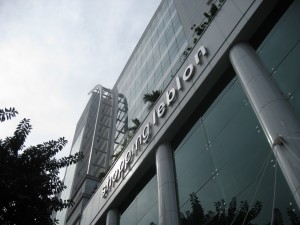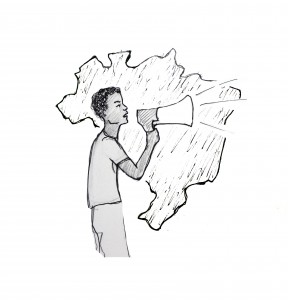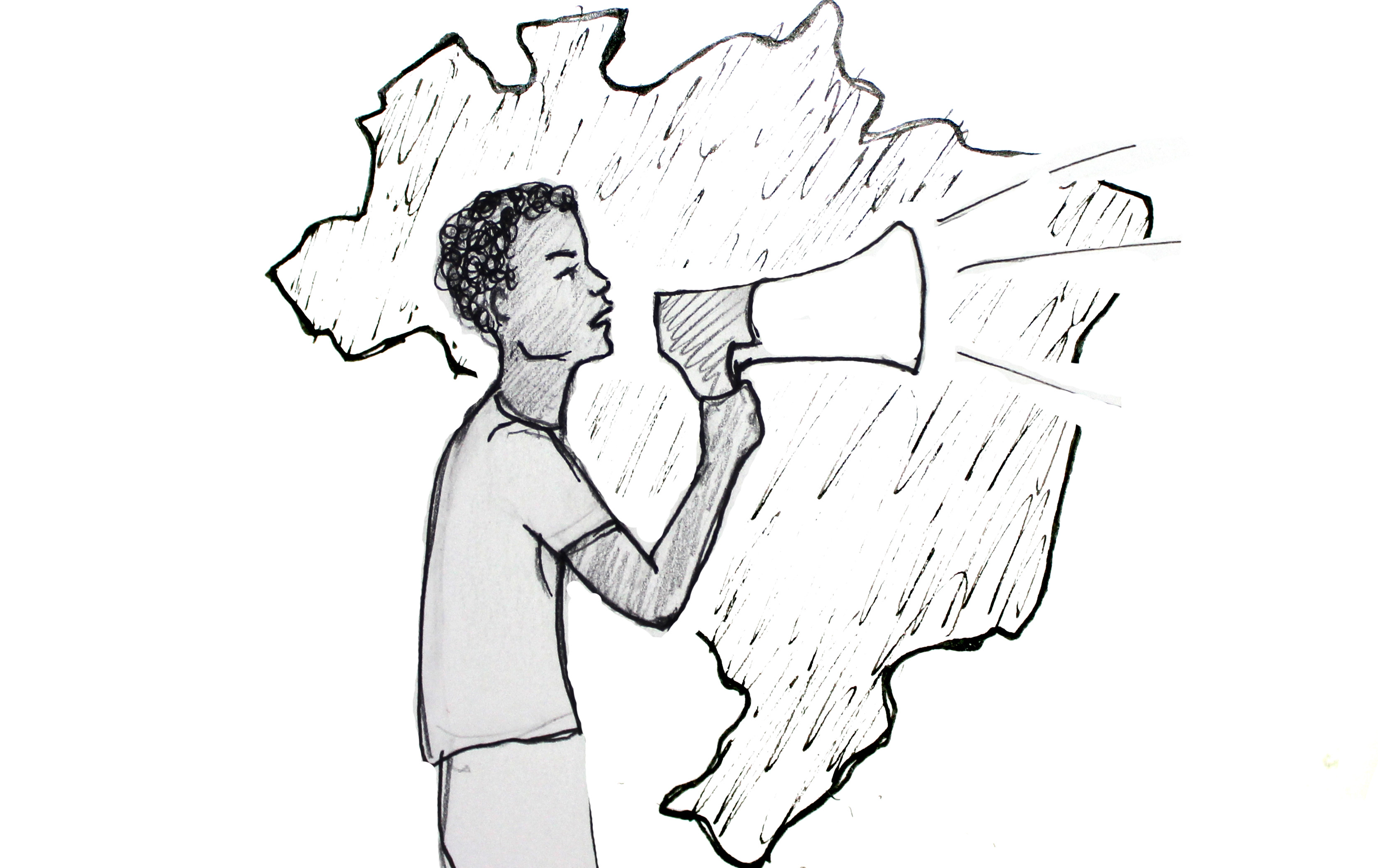What happens when 8,000 people decide to go to the mall together? This is not the tagline of a B movie about Black Friday. Instead, it is becoming a legitimate question in Brazilian society, generating debate over crucial public issues of race, class and urban planning. A new chapter in Brazil’s recent wave of youth mobilization, the mass mall gatherings, called ‘rolezinhos’ (little strolls), are now sweeping the country’s urban centers, putting the spotlight on a long-marginalized class of young people from the urban periphery.
Since December, rolezinhos have descended on malls in Rio de Janeiro and Sao Paulo. The vast majority of those who join the crowds come from neighborhoods that are poor and marginalized, mostly from the urban periphery — yet the same neighborhoods that increasingly partake in Brazil’s economic expansion and general trend towards greater social mobility. The gatherings themselves involve a lot of running around (sometimes from the police), singing of ‘Funk’ (a rap-like musical genre popular in ‘favelas‘) and making general raucous. There have been accusations that some rolezinhos have resulted in shoplifting or even mass robberies, but the vast majority of them seem peaceful until the police get involved.

The first rolezinho of note took place on December 8, at the Metro Itaquera mall in Sao Paulo. It is hard to pinpoint what sparked this first gathering. The culmination of a chronic lack of safe public space combined with the large number of malls in Sao Paulo, the welcome air-conditioned environment in contrast to the scalding 95 degree summer heat (Fahrenheit), as well as the fact that teenagers were off from school may each point to an answer. At least in this first rolezinhos, it seemed like the goal was to have fun, as opposed to making an overt political point. Organized through Facebook, the Metro Itaquera rolezinho gathered 6,000 people. Employees closed their stores and called the police, fearing an ‘arrastao‘ (mass robbery) – a frequent occurrence in cities involving large groups of young men sweeping an area, stealing from pedestrians as they go.
Armed police soon cracked down and arrested two men for stealing before quickly dispersing the crowd. But only three days later, a second rolezinho assembled on another Sao Paulo mall, drawing around 2,500 people. This time, police were alert and on edge: 22 people were arrested because they were “about to start a robbery.” Soon, Facebook events for so-called ‘solidarity rolezinhos’ began popping up organically, in response to the aggressive police actions. In a classic snowball effect, more events were scheduled, with greater and greater numbers of people planning to attend. Unlike the separate mass political demonstrations that took place last June, rolezinhos were not sparked by a particular group or driven by an expressly political agenda, at least not initially. The birth of a rolezinho goes something like this: someone creates a Facebook event, it starts to trend, and soon enough, thousands of people are at the doorstep of a Sau Paulo mall.
On January 11, another rolezinho occurred in Metro Itaquera — now ground zero for the movement. This time, the police responded with tear gas and rubber bullets. Videos of police officers in Metro Itaquera striking at will with nightsticks against those attending the rolezinho (many of whom were minors) popped up across the Internet.
It appears that rolezinhos were initially more a social event than a political protest. In fact, many of the people attending (or ‘rolezeiros‘, as they’ve come to be known) claimed they were only there because they had nothing else to do – a symptom of the chronic lack of safe public space in Brazil’s urban centers, especially in poorer neighborhoods. When asked why they attend, a common response among male rolezeiros is “to meet girls.” It was the police response that infused the rolezinho with its new political edge.
Brazilians face a reality in which police in Brazil act with few scruples when it comes to the poor. The daily burdens many are subjected to – constant suspicion, unwarranted searches, being h ld without charges and often worse – are mostly foreign to the overwhelmingly white members of the elite and upper-middle class. But as growing numbers of Brazil’s poor are lifted into the lower middle class and begin occupying spaces previously dominated by the rich, tensions inevitably arise — hence the political significance of the rolezinhos, and the police response which has, at times, appeared arbitrarily violent.
ld without charges and often worse – are mostly foreign to the overwhelmingly white members of the elite and upper-middle class. But as growing numbers of Brazil’s poor are lifted into the lower middle class and begin occupying spaces previously dominated by the rich, tensions inevitably arise — hence the political significance of the rolezinhos, and the police response which has, at times, appeared arbitrarily violent.
Rolezinhos remind us of the increasing social mobility of the poor, but also the growing consumerism across all social classes. Much of the Funk that is played and sung during rolezinhos is a sub-genre called Funk Ostentacao (Ostentatious Funk), with lyrics full of brand names and artists that wear large gold chains and drive expensive cars. In Brazil especially, consumption brings status — exactly what one is desperately searching for when treated like a second-class citizen. At least in the beginning of the movement and before its political reformation, rolezinhos were gatherings in which an emerging class could meet to show off their new powers of consumption, limited as they might still be, and take part in the consumer culture that has long excluded them by assembling in that utmost temple to modern consumption – the shopping mall. They have served to illuminate the fact that even as the purchasing power of the poor has improved, their neglected place in society has not.
As the police response to rolezinhos became more violent, the movement grew bolder. Gatherings convened with quickening speed and even greater numbers. Now they not only infiltrated middle-class malls, but also some of the most upscale malls in Rio and Sao Paulo – the kind where shoppers are overwhelmingly white and where even small groups of people who do not fit the profile of the usual shopper are treated with suspicion by mall security. When a rolezinho was organized at JK Iguatemi, one of Sao Paulo’s most luxurious malls, security set up a series of checkpoints near the entrance. ‘Unaccompanied minors’ were stopped at the first checkpoint; anyone who looked ‘suspicious’ was stopped at the second and asked to show ID. People who were richly dressed and had whiter skin were not stopped.
Now several malls have acquired court orders to block the rolezinhos. The exact mechanism through which mall employees will sort out who is taking part in the rolezinho and who is only there to shop remains uncertain. To avoid this fragile situation altogether, some malls have simply closed on the day rolezinhos were scheduled to take place. Such was the case at Shopping Leblon, an upscale mall in Rio’s exclusive Leblon neighborhood. Roughly 8,000 people had confirmed attendance on Facebook the day before the event was supposed to take place on January 19. The description of the Shopping Leblon rolezinho read: “We support the people in Sao Paulo, against all forms of repression and discrimination against the poor and those of African descent, and especially against the brutal and cowardly actions of the police, be it in the malls, the beaches, or the periphery.” The event’s political manifesto sounded a far cry from the Facebook descriptions of rolezinhos past, which rallied rolezeiros to “go up the down escalator,” and “press all the elevator buttons.”
When the crowd arrived at Shopping Leblon to find the doors locked, they turned on the Funk, and lit up the grill to make the typical ‘churrasquinho de gato‘ (cat barbecue – alluding to the poor quality of the meat being cooked). These two things are, in way, symbols of the lower and lower-middle classes, and for just one day, they dominated an area that boasts the most expensive real estate in Latin America. In a way, the defining political goal of the rolezinho was finally realized, despite the locked mall doors: congregating and re-enforcing their identity in a space usually exclusive to the wealthy.
In general, malls have been successful in acquiring court orders that prohibit the gatherings, citing overcapacity and fire hazards as reasons for doing so. Regardless, social media is still buzzing, and additional events are planned daily. Some rolezeiros are attempting to reconcile the legitimacy of these courts orders while still attempting to leverage the growing online buzz, negotiating with mall authorities and proposing the idea of permitting limited rolezinho presence in malls, while the majority of those attending would congregate in open areas outside. From the perspective of the gatherings’ organizers, the location of the mall symbolizes a space normally exclusive to the well off. A portion of those attending must occupy the space inside the mall, or the significance of the event is, in a way, lost. Other groups have tried to appropriate the rolezinhos as their own, taking advantage of their newfound popularity. Anti-racist groups and the ‘Blac Bloc’ (a group of protestors prone to vandalism that became protagonist in the wave of mobilization that dominated Brazil last June) have called for their own ‘pseudo-rolezinhos.’
Today, rolezinhos continue to split the Brazilian people along class, racial and political lines. Brazil’s political left says the rolezeiros are fighting the pseudo-apartheid that is endemic to Brazil; the right believes rolezinhos are excuses for theft, vandalism and public disorder. The truth is probably somewhere in the middle. Many rolezeiros attend the gatherings for political reasons, some just want to have fun, and others, a small minority, are there to take advantage of the situation and create disorder. If anything, rolezinhos are generating debate over veiled structural racism and social exclusion in Brazil – a debate that is ever-present in Brazilian culture but that has never had a movement to truly exemplify its importance, until now.
